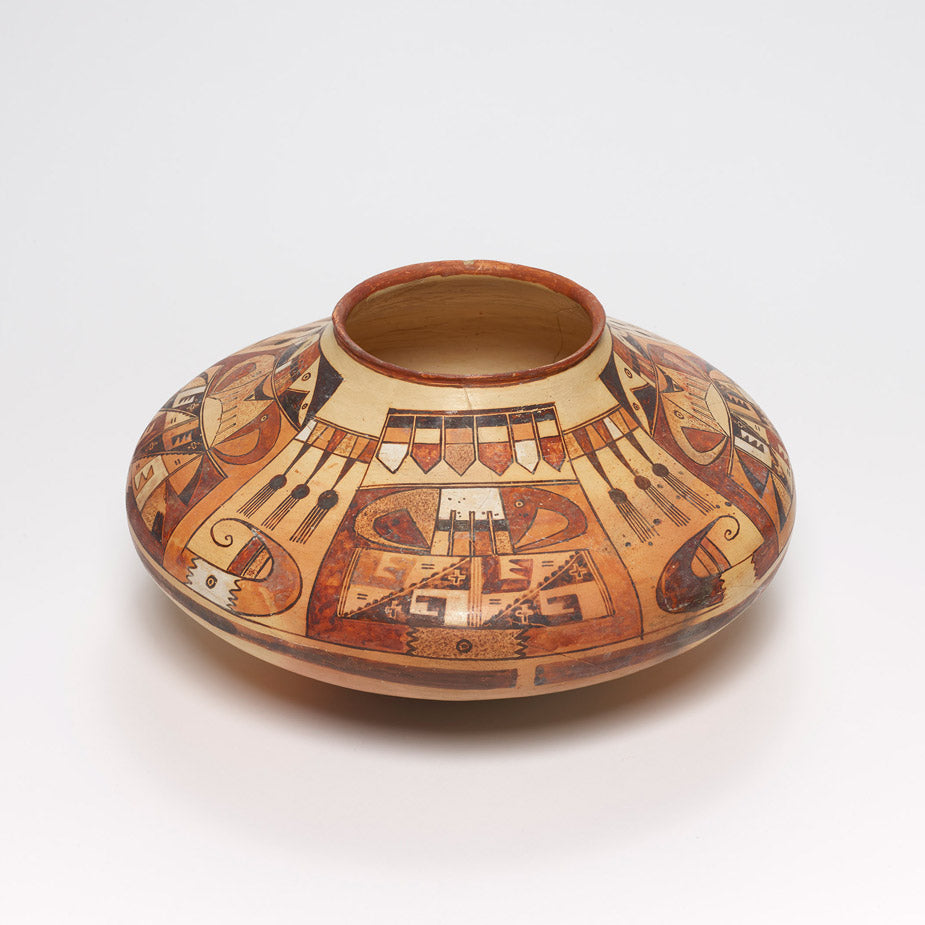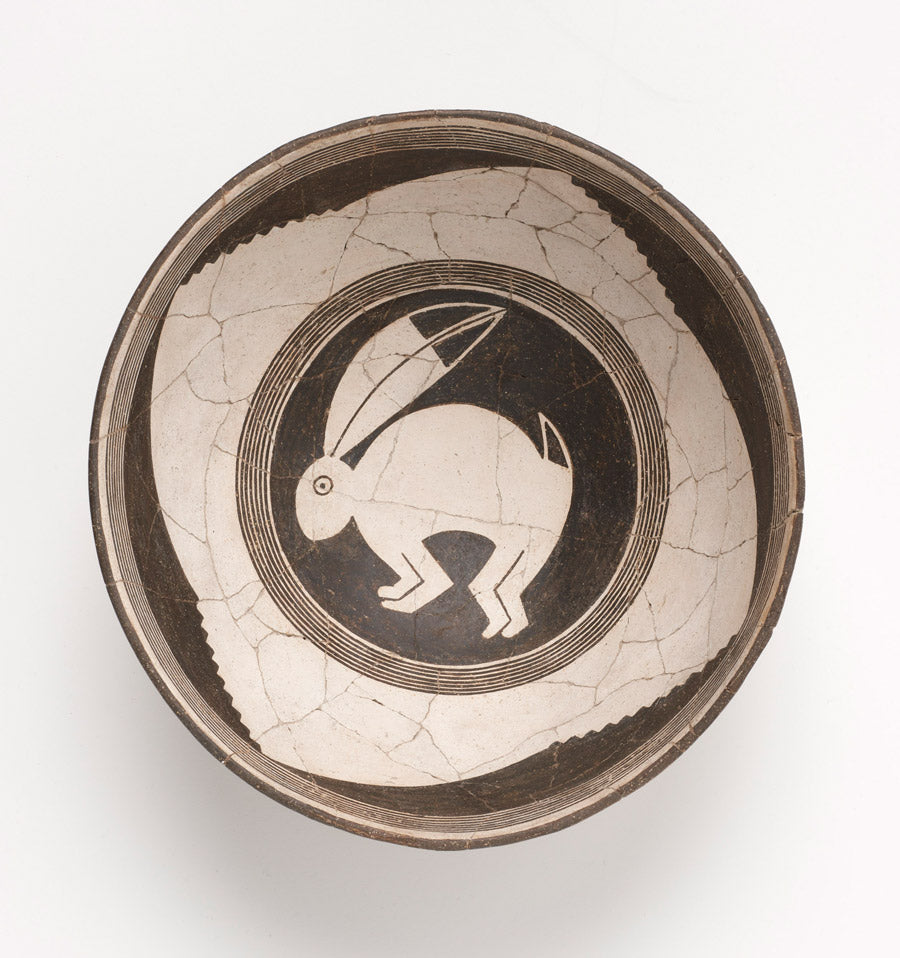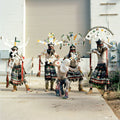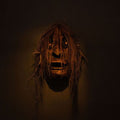Fine Arts Museums of San Francisco publish new catalogue of Native American art
By Medicine Man Gallery on

Ancestral Hopi artist, Sikyatki, Jar, ca. 1450–1500. Earthenware and pigment, 20.5 x 40.5 x 40.5 cm. Gift of the Thomas W. Weisel Family to FAMSF, 2013.76.140. Photograph by Randy Dodson, copyright FAMSF
Not everything is meant to be seen. Even artwork. Even when it’s in a museum.
Consider the Mimbres bowls and ancestral pottery – predating 1600 – in the collection of the Fine Arts Museums of San Francisco. In its catalogue “Native American Art from the Thomas W. Weisel Family Collection,” published in April of 2023, numerous items are entirely obscured by a matrix of gold dots or reproduced as drawings.
In producing the book, FAMSF staff collaborated with a cultural advisory group including Joseph R. Aguilar (San Ildefonso), Stewart B. Koyiyumptewa (Hopi), Arden Kucate (Zuni), Christopher Toya (Jemez) and Brian Vallo (Acoma). They were the ones who informed decisions on which specific items were too sensitive to be shown and which among them could be depicted in drawings, but because of their likely use in burials, were not appropriate to photographically reproduce.
“It was important in this project to create a book that represented, embodied and spoke to the complexities of the field of Native American art,” Hillary Olcott, Associate Curator Arts of the Americas at the Fine Arts Museums of San Francisco and one of the catalogue’s co-editors, said. “It's an enormous field. It's multi-layered, there are many stakeholders, many, quote unquote experts, many voices to include.”
The treatment represents a novel approach to the institutional presentation of Indigenous material culture. It also demonstrates how far the museum field has come in a short amount of time regarding the display of sensitive Native American artworks. In 2014, FAMSF published another catalogue of reproductions from the Weisel Collection that did not obscure sensitive items.
“We wanted to figure out a way in which we could expand the conversation to involve Pueblo cultural leaders and community members and we also wanted to make a space for foregrounding Pueblo understandings of this ancestral pottery material rather than perpetuating conversations about ownership or conversations about artistic heritage,” Olcott said. “It was really important for us to shift the conversation and make space for another set of values.”
The Mimbres
The history and treatment of Mimbres bowls are particularly complex.
As one example, type “Mimbres” into a Microsoft Word document and it will be underlined in red as an incorrect spelling. That’s not the case with Acoma, Zuni, Hopi, Tesuque, Taos, Laguna, Jemez, San Ildefonso or Pojoaque.
The Mimbres were a branch of the Mogollon cultural tradition which covered much of what is now the American southwest from central Arizona to west Texas and down into northern Mexico. The Mimbres were concentrated around southwestern New Mexico and northern Mexico.
Mimbres is Spanish for “little willow,” that name paired with the main river running north to south through Mimbres territory.
The Mimbres people are believed to have left their ancestral homeland and been absorbed in to neighboring communities. Uncertainty from Western scholars about why, or if, this was actually the case places the Mimbres almost more into the category of legend than history.
Mimbres ceramics are among the earliest pottery traditions to emerge in the Southwest, beginning around 200 CE with the culture reaching its peak between 1000 and 1130. The Mimbres eventually left the region around the 1200s.

Ancestral Puebloan artist Mimbres bowl, ca 1010 – 1130. Earthenware 4 x 10 x 10 in. Gift of the Thomas W. Weisel Family to the Fine Arts Museums of San Francisco, Photograph by Randy Dodson, copyright the Fine Arts Museums
Mimbres Bowls
The Thomas W. Weisel Family Collection gift of Indigenous artwork to the Fine Art Museums of San Francisco included 58 Mimbres pottery items, one of the finest such collections in the world.
Mimbres bowls are distinguished by their placement of imagery inside of bowls instead of on the exteriors, and for their precise, highly detailed black-on-white designs featuring a “combination of complex geometric patterns and elaborate images of fish, birds, and other zoomorphic forms, some portrayed in surreal combinations,” as explained in the catalogue. They have long been valued as exceptionally exquisite objects of Puebloan cultural production.
“The Mimbres’ pottery still is the center of a lot of public dialogue in the museum space about this divide between, often, (a) museum's practices and the goals or values of the Native communities that are associated with these artworks,” Olcott said.
For “Native American Art,” FAMSF and the advisory group studied each item in the collection individually to determine whether it was appropriate to photograph and publish as-is, to depict as a drawing by Acoma artist Michelle Lowden, or to obscure it entirely.
“The individual consideration of the works was very important because, in the words of one of our advisors, Joseph Aguilar, he said that this process was partially to correct non-Pueblo peoples’ generalities about these works, and it’s true, there are generalities – we see them as Mimbres bowls – but each bowl has a history, it’s a living object and has meaning of its own,” Olcott said.
Fundamental to any understanding of all Pueblo pottery, Mimbres or otherwise, ancestral or contemporary, is that they are not merely utilitarian. Each has a unique spirit. A story to share.
“Spiritual knowledge is essential for any Pueblo potter. My first lesson in pottery was to respect clay as a living entity,” Tewa-Zuni potter and painter Les Namingha writes in an essay for “Native American Art.” “I was also taught that I should pray continually throughout the pottery-making process, the vessel becoming a symbolic receptacle for my supplications and gratitude.”
These realities are amplified when thinking about Mimbres bowls.
“Viewers of Mimbres pottery should understand that the clay vessels are more than works of art; they were created for sacred purposes, including for burial rites,” Tewa-Zuni potter and painter Les Namingha writes in an essay for “Native American Art.” “The knowledge that such wares were taken from desecrated burial sites might justifiably temper the enthusiasm of those who view these pieces solely for their aesthetic value.”
Namingha’s point strikes at the crux of tension between Indigenous communities and the Western-run art museums around the world displaying their cultural objects, a point Olcott acknowledges.
“There is just completely conflicting value systems that we're grappling with, and the reality is that even if (these items) really shouldn't be in the museum space, they are, so how do we move forward,” she said.
The Mimbres items in the Weisel Collection were acquired from dealers and other collectors; each item’s provenance is detailed in the catalogue. While there is no intention on behalf of the museum to see any of the items leave the institution, it continues working with the cultural advisory group on how they are taken care of and are stored.
Artworks not photographically reproduced in the book are not on view in the museum.




